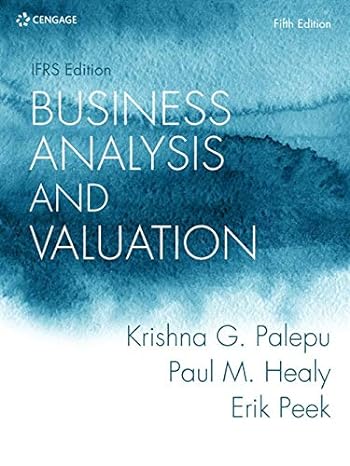One of the key accounting policies of banks and other financial institutions is how they recognize (changes
Question:
One of the key accounting policies of banks and other financial institutions is how they recognize (changes in) the fair value of the securities that they hold in the balance sheet and income statement. Until the implementation of IFRS Standards 9 (effective since 2018), the international rules on the recognition and measurement of financial instruments required a firm to recognize financial securities (other than loans and receivables) at their fair values if the firm did not intend (or was not able) to hold these assets to their maturities (labelled held-for-trading instruments).
Changes in the securities’ fair values had to be recognized as gains or losses in the income statement.
Financial securities that a firm initially intended to hold to their maturities but that were available for sale also had to be recognized at their fair values. However, changes in the fair value of these available-forsale securities were temporarily recorded in equity and recognized in the income statement once the securities had been sold. If the firm intended to hold the financial instruments to their maturities (held-tomaturity instruments), they had to be recognized at (amortized) historical cost.
How should the fair values of financial instruments be determined? The rules required (and still require) that the values be derived from quoted market prices if an active market for the assets exists (typically referred to as marking to market). If quoted market prices were not available, firms could use their own valuation technique to determine the assets’ fair values (referred to as marking to model); however, their valuation had to be based on assumptions that outside market participants would reasonably make, not management’s own assumptions.
Complications arose if quoted market prices were available but, at least in the eyes of some, unreliable.
For example, the credit crisis of 2008 led to a substantial increase in the uncertainty about the quality and value of asset-backed securities, such as mortgagebacked loans. As a result of the heightened uncertainty, investors fled asset-backed securities, and the market for such securities became highly illiquid.
Observable prices from infrequent transactions remained available; however, managers of financial institutions owning asset-backed securities claimed that these prices did not properly reflect the values of the securities if one had the option to hold on to the securities until the crisis was over or the securities matured. In response to these claims, the IASB provided additional guidance and reemphasized that in declining, illiquid markets, managers had the option to use their own valuations to determine fair values.
Consequently, many financial institutions chose to move away from marking to market towards adjusting market prices or marking to model.
Prior to the credit market crisis of 2008, an important detail of the international accounting rules for financial instruments was that instruments could not be reclassified between categories (with the exception, of course, of reclassifications from held-to-maturity to available-for-sale). The crisis, however, led some bank managers to change their minds about which securities were actually held for trading purposes and which securities were better held to their maturities.
Under great political pressure from the EU, the IASB amended this rule in October 2008.23 The amendment allowed firms to reclassify securities out of the held-for-trading category in rare circumstances, such as those created by the crisis, if management decided not to sell the securities in the foreseeable future. A survey carried out by the Committee of European Securities Regulators (CESR) revealed that 48 out of 100 European financial institutions reclassified one or more financial instruments in their financial statements for the third quarter of 2008.
1 Discuss how the changes in the reclassification rules affect the balance between noise introduced in accounting data by rigidity in accounting rules and bias introduced in accounting data by managers’ systematic accounting choices.
2 The move from marking to market to marking to model during the credit crisis increased managers’ accounting flexibility. Managers of financial institutions may have had incentives to bias their valuations of financial instruments.
Summarize the main incentives that may have affected these managers’ accounting choices.
3 Some politicians argued that fair value accounting needed to be suspended and replaced by historical cost accounting. What is the risk of allowing financial institutions to report their financial securities such as asset-backed securities at historical cost?
Step by Step Answer:

Business Analysis And Valuation
ISBN: 978-1473758421
5th Edition
Authors: Erik Peek, Paul Healy, Krishna Palepu





